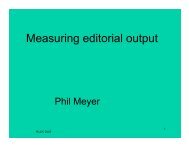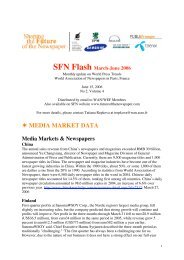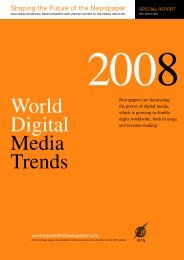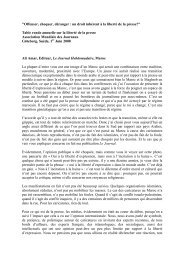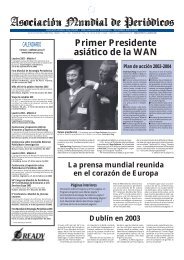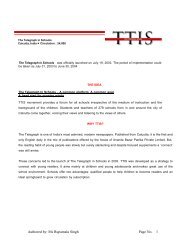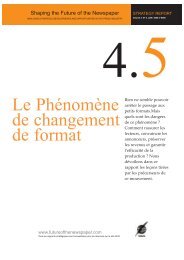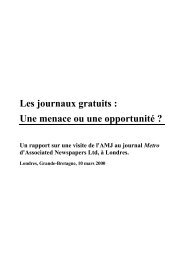WORLD PRESS TRENDS - World Association of Newspapers
WORLD PRESS TRENDS - World Association of Newspapers
WORLD PRESS TRENDS - World Association of Newspapers
Create successful ePaper yourself
Turn your PDF publications into a flip-book with our unique Google optimized e-Paper software.
CHINA<br />
Commentary - China Education Daily<br />
China’s newspaper industry is very polarised. A few huge titles<br />
circulate more than a million copies an issue, but there are many<br />
that circulate less than a thousand. A few are very pr<strong>of</strong>itable,<br />
while plenty make consistent losses. Rural publishing remains<br />
depressed, while city newspapers are booming.<br />
The city newspaper market has become more and more active<br />
since China joined the <strong>World</strong> Trade Organisation (WTO) in 2001.<br />
Price wars have broken out in several cities. They began in<br />
Guangzhou, the capital <strong>of</strong> Guangdong province in south China.<br />
Guangzhou Daily, Nanfang City News, Yangcheng Evening News,<br />
Information Times and News Express either cut prices directly,<br />
increased the number <strong>of</strong> their pages, or gave away items like<br />
TV sets, cars, microwave ovens and so on. The war then spread<br />
from Guangzhou to Shenzhen and other cities. In Shenzhen<br />
the city authorities stepped in to force the Nanfang City News to<br />
stop publishing there after it attempted to compete with the<br />
local newspapers.<br />
Price wars soon reached provincial capitals, such as Changsha,<br />
Chengdu, Nanchang, Nanjing, Wuhan, Xi’an, Zhengzhou and<br />
in several midsize cities, such as Dalian, Qingdao, and Wenzhou.<br />
Some provincial authorities responded by fixing a mandatory<br />
price for all city newspapers. For instance, the Department for<br />
Press and Publishing in Hubei ordered all newspapers<br />
distributing in Wuhan to sell at RMB 0.50, and the Jiangsu<br />
government has forbidden any newspaper distributed in<br />
Nanjing to sell for less than RMB 0.30. In other provinces,<br />
publishers have formed tacit agreements or cartels to fix prices.<br />
Some newspapers’ subscription prices and promotions in 2003<br />
CHINA<br />
City newspapers published in the same area tend to have very<br />
similar cover prices, as one might expect from a competitive<br />
industry. The cover prices <strong>of</strong> provincial-level government<br />
newspapers vary more widely, and those <strong>of</strong> special newspapers<br />
(economic, educational, cultural and other industrial<br />
newspapers) more widely still. This is because they don’t worry<br />
much about demand and pr<strong>of</strong>itability, so there is no market<br />
mechanism for setting their prices.<br />
Distribution <strong>of</strong> cover prices (logarithmic scale)<br />
No. titles<br />
1,000<br />
100<br />
10<br />
1<br />




